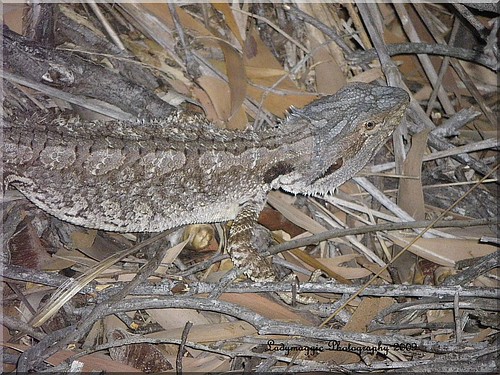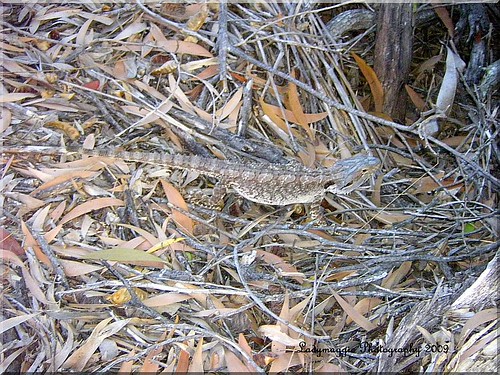http://www.australianreptilepark.com.au/animals.asp?catID=11&ID=82
Scientific Name: Pogona barbata
The harsh, spiky appearance of these lizards belie their normally placid temperament. If approached in the wild, the bearded dragon's usual response is to freeze and rely on its camouflage. If further threatened they puff themselves up, extend the 'beard' under the throat and open the mouth wide to reveal the bright yellow lining. If picked up, they will continue to struggle but will rarely bite. At a total length of around 55cm, the grey-brown eastern bearded dragon is an impressive animal.
Did You Know? In southeastern Australia the bearded dragon is often erroneously called a 'frilly'. The true frilled lizard occurs only in northern Australia and has a frill around the entire head. Bearded dragons are only able to extend the throat region by the use of a moveable piece of cartilage. The intention is the same, however, to try and make the lizard look larger than it actually is to something that is thinking about trying to eat it.
Habitat: Distributed the length of the eastern quarter of Australia, eastern bearded dragons are common in open forests, heathland, scrub and even some disturbed areas such as farmland. Their main requirement are trees that they can utilize for escape, sun-baking or to simply survey their territory. If trees are in short supply, they will use fence posts as an alternative, jumping to the ground to catch a passing insect or to chase off an intruding bearded dragon.
Diet: Adult bearded dragons eat a great deal of vegetable matter, possibly as much as 80-90% of their total diet. Leaves, fruits, berries and flowers are all eagerly consumed. Insects make up the balance of the adult diet and the majority of the juvenile diet.
Reproduction: In spring male dragons keep a close eye out for passing females, attracting their attention with a series of frantic head bobs and arm waving. A month or so after mating, the female lays a clutch of 10-20 oval shaped white eggs with soft, flexible shells. These are laid in a shallow hole dug into the soil in an open sunny spot. The eggs hatch after around two months of incubation. In good seasons two or three clutches may be produced by a single female
Perfectly camnouflaged and as still as still
So still and the dog is almost standing on its tail, but still he stays for his safety




140x45.jpg)




No comments:
Post a Comment